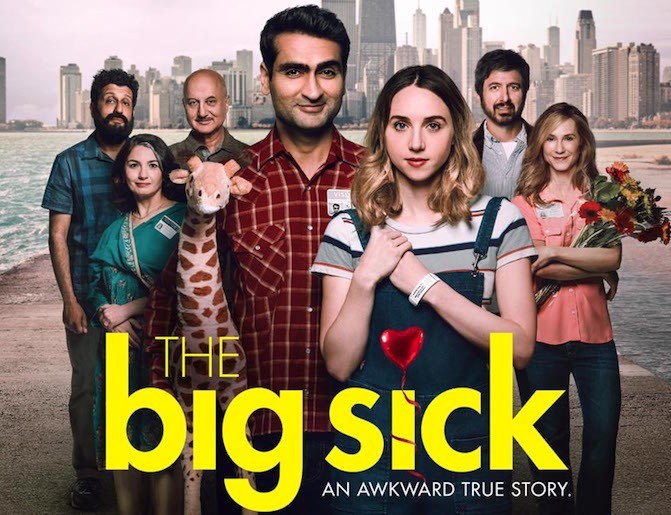
Credit to the Lowdown Under
I’m not like a big rom-com guy. I don’t know if that’s because I grew up in a household of four brothers, all of who (Sure, whom, but that just doesn’t sound right, and I’m not a hardcore prescriptivist) preferred action movies, or because of some underlying genetic predisposition against romantic comedies. Maybe I haven’t seen very many, and that’s why I wouldn’t consider myself a lover of the genre. Despite all of that, I really liked the latest Hollywood Rom-com, The Big Sick. I think it’s cuz it’s based on a true story. That’s why it was good. Why I liked it. It was a rom-com where one half of the relationship was only present for the first forty-five minutes, and then the last fifteen, atypical of the average rom-com. The girl was missing for the majority of the plot development, and the movie was conscious of that.
The plot: Kumail Nanjiani, the Pakistani stand-up comedian whose name consists of two red underlines in Microsoft Word, plays himself in The Big Sick. It’s about him, the beginning of his career, and a girl named Emily. The film takes place in Chicago, centering primarily around Kumail’s apartment, a comedy club, and a hospital. The title itself is a mild spoiler, as one of the main driving elements of the plot is Emily’s sickness, and subsequent stay in the hospital. This sickness is what removes her from the screen, and allows Kumail to sort of “discover who he really is” with the help of Emily’s parents, Mr. and Mrs. Gardner (the latter rather distractingly played by Holly Hunter, the voice of Helen Parr [Mrs. Incredible] in Pixar’s best film, The Incredibles).
As I’ve stated, one of the more interesting aspects of the film is Emily’s lack from it. Not that Zoe Kazan is a bad actress (actor?), far from it. I was simply compelled by the lack of a female lead in a genre which has previously required a woman lead to clash dramatically with the male lead. Yeah, there’s clash, but that’s not what the movie’s about, which is refreshing. The movie is about life, in the least cliché way possible, and that’s why it works.
Start with Kumail. He’s not a great comedian (in the movie, I mean; We all know that he eventually does quite well) and is clearly struggling financially. He lives with another comedian (one who is considerably worse) and his only two other friends (played by Bo Burnham and Aidy Bryant) are also comedians who are just doing their best. It’s every normal twenty-something in the United States, just trying their best to pursue what they love. Kumail’s apartment is a mess. I mean it’s truly horrendous, with stacks of books (paperbacks, not even good ones, the viewer can assume) littering the floor, a Shaun of the Dead poster on the wall (Kumail has good taste in movies at least) and an air mattress on the floor. He is, in nearly every aspect, a single American straight out of college. And here’s the amazing thing about that: it doesn’t feel forced. Emily V. Gordon (the real Emily) and Kumail teamed up to write a jarringly realistic script, and they succeeded, avoiding the poor-middle-class-American clichés that screenwriters seem to love.
One of my favorite sections of the movie dealt with Kumail’s family, who immigrated from Pakistan, and are devout Muslims who hold deeply to their faith. This is a family who is trying to set up a pseudo-arranged marriage with their son in the early 2000’s. It’s a bit of cultural clash, one that could play itself out in a very I’m-my-own-person-and-I-refuse-to-be-bound-by-society’s-standards sort of way. The tense confrontations and awkward situations between the family and Kumail allow for good social commentary (and maybe some understanding of a different worldview) for moviegoers, while allowing comedy to play itself out naturally, forcing nothing.
Something I wasn’t fully conscious of until after the film was the suspense. In the average rom-com, you know exactly how everything is going to end. Here’s the plot:
- Boy meets girl.
- They date or at the very least hookup.
- Someone screws up.
- They fight.
- They grow.
- They come back together.
The Big Sick doesn’t operate within these boundaries, and it’s compelling. You honestly don’t know how the movie will end, and the best part about that is the acceptance of this fact. It’s such a good story that you aren’t necessarily worried about Kumail and Emily. If they don’t get together, that’s ok. They’re great people, who had an interaction, and could theoretically move on with their lives without ever seeing one another again. What I’m trying to say is that The Big Sick doesn’t rely on the genre’s stereotypes to keep it afloat.
While I sat in the theater (which, btw, was kept far too cold) I felt a connection between myself and the characters on the screen. That’s what you want out of a rom-com after all, because everyone is looking for connection or affirmation in one way or the other. It felt different for The Big Sick, because it felt real. It wasn’t contrived in some studio apartment by a guy with an MFA, or an old rom-com writer who hasn’t had a big hit since she wrote a movie in the 90’s. It was written by the people who lived it, and it shows. The Big Sick draws you in, and keeps you watching the screen for two hours, truly unsure about how things will work themselves out. It’s about life, and the comedy in the mundane. Life is funny, and Kumail and Emily managed to capture that and hold it in a beautiful, moving screenplay.
The Big Sick gets 5.5 Clarks out of a possible 7. Still trying to figure out this rating system.